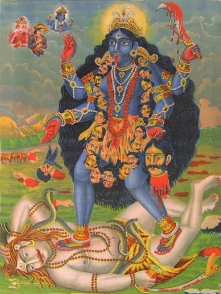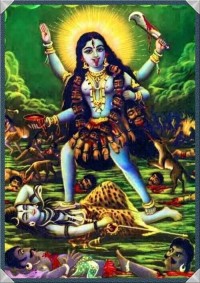The following two visions of Kali—one by Paramhansa Yogananda when he was the young Mukunda and the other by the Bengali poet Ramprasad Sen—are described by Swami Kriyananda in his book Paramhansa Yogananda: A Biography.
These two stories highlight an important feature of God: even though Kali is normally depicted in painting and statue with a specific form, features, and personality, She can take on any form. In Yogananda’s vision she was “beautiful.” Ramprasad saw Her as a young girl. Of course She is without form, and in all forms. This chant wryly chides those who would limit the Divine Mother to any single form:
Who tells me Thou art dark [referring to the dark-skinned Kali], Oh my Mother Divine,
Thousands of Suns and Moon from Thy body do shine!
~ Nayaswami Devarshi
* * * * * * *
Mukunda, as I said, worshiped God especially in the form of Mother of the Universe. Because his friends knew this was the focus for his devotion, they would happily bring him news of any new Kali temple they found in the vicinity. One day they came to him bearing tidings of a new temple.
Mukunda smiled. “You all go, if you like. This evening I prefer to stay home.”
“Stay home! But why?”
Mukunda only smiled. His friends went to the temple, prostrated themselves before the image it held of the Divine Mother, and chanted a few devotional songs. Their hearts were uplifted, but the upliftment lasted only for that evening.
At home, Mukunda went up to his attic room. Temples, too, have value, primarily as aids to bringing people’s devotion to a focus. But Mukunda’s devotion had long since achieved that focus at the point of superconscious ecstasy in the forehead—that is to say, in the frontal lobe of the brain behind that point.
“Mother with lotus feet!” he prayed. “Mother with hair spreading out over all creation! O Mother, come to me! Mother, your smile twinkles in a million stars. O Divine Mother, tear asunder this veil of darkness which hides You from me!”
Long he called to Her. Years earlier, when he had lost his earthly mother, his aching love for her had been redirected to the Divine Mother of the Universe. (Wise Child! Instead of grieving over our earthly losses, we should direct our love to God, where every pain becomes a blessing.) And now at last that Mother of all mothers had appeared to him!
“Kali!” he whispered. “Mother Kali, You have come! Oh, how beautiful You are! Mother, may my life be a song of constant love for Thee!”
The Divine Mother smiled. “Your prayer is granted, My child. Though you shall have to travel far, and bring many souls to My all-sheltering arms, in your heart of hearts you will always be at rest in My formless presence. And as often as you call to Me, whenever you desire it, so often shall I appear before you in this form.”
Mukunda (Yogananda) called Kali, when seen in vision, “beautiful.” But certainly the images presented of Her are anything but that. She is depicted with four arms, a garland of skulls, her hair unkempt and straggling out in all directions, her tongue lolling out of Her mouth, standing (as if in triumph, as the Westerner would perceive her) on the prostrate form of Her husband, Shiva. All this, however, is deeply symbolic. The English thought of Her as the goddess of death, the form worshiped by Thuggees (a band of criminal assassins). Yogananda explained this symbolism to us:
Kali represents Mother Nature. Her four arms symbolize Creation, Preservation, and Destruction, the fourth depicting the gift of salvation to those who go beyond Nature to the heart of Infinity. The garland of skulls signifies Her divine omnipresence in all human minds. Why skulls? Because all human life is temporary. Her hair streaming outward signifies God’s energy reaching out through all Creation. In Her dance, the rhythmic steps signify the vibratory nature of Creation. Her husband Shiva is depicted as lying prostrate, because God the Father, the Eternal Spirit, is beyond Creation, beyond all vibration, alive in the vibrationless void of Brahman (Spirit).
Kali’s dance ceases when Her light footsteps touch the breast of the Infinite. The reason She is shown with Her tongue out is that She suddenly realizes She has gone too far! Finitude cannot penetrate into the heart of Infinity.
In India, one bites his tongue, sticking it out a little beyond the teeth, when he is conscious of having made a mistake. Even in Western countries, this is a common, instinctive gesture.
Needless to say, many Indians, too, fail to understand this deep symbolism, and assume that Kali’s tongue is lolling out in blood lust; that her streaming hair suggests almost a harridan raging about to find whom she may devour next. The garland of skulls suggests to them, again, blood lust. And the four arms seem to serve no purpose at all. Her position, standing on Shiva’s breast, is taken for a posture of victory.
Indian images of God are often deliberately not beautiful, in order that the devotee may not be deluded into thinking that any image can ever define the Infinite. The images of Kali are certainly not beautiful. Yet She has been worshipped by many great saints and masters, including Yogananda and Sri Ramakrishna.
Ram Proshad, a great poet-saint of the seventeenth century, worshipped Kali also. One day he was mending a fence on his property, when his daughter came and helped him. He’d been singing. His daughter asked him, “To whom are you singing, Daddy?”
“I am singing to my Divine Mother Kali. But she’s very naughty! Though I often sing to Her, She never comes to me.”
“If She never comes, Daddy, why do you keep on calling? Isn’t it all a useless waste of time?” With a light laugh, his daughter then ran away.
Later that day, his job finished, Ram Proshad went indoors. There he told his wife how their daughter had been helping him. The wife replied, “That isn’t possible. She’s spending the whole day on the other side of town with some friends.”
When their daughter returned that evening, he questioned her. She answered, “Daddy, you can ask anybody. I wasn’t here. I was far away, on the other side of town.”
And then Ram Proshad realized that it had been his Divine Mother, coming to him in the form of his daughter, and teasing him by saying, “If She never comes, why do you keep calling to Her?”
So you see, Kali comes in many forms, and rarely, if ever, in the form one beholds in the temples. She can also be infinitely kind, friendly—even teasingly playful! Her eyes, however, though childlike, reveal also the deep, ego-free calmness of Infinity.









































Berry nice and beautiful, thanks!!
Om Kali thanks for sharing such a soul touching message